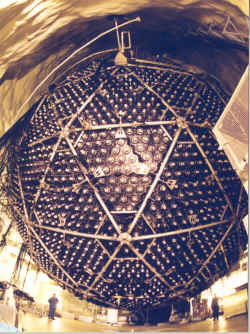Neutrino Models Aren’t Separable

The Sun has never delivered as many neutrinos as traditional theories predicted, but experts expect the deficit to be explained by a better understanding of neutrinos: For one thing, they appear to have mass, an old idea that has been confirmed by recent data. As researchers home in on the new physics of these particles, they often neatly divide their theories between two types of models that account for the neutrino deficit in different ways. But according to the 31 July PRL, there is actually an important overlap region between the two which the community has largely ignored.
If neutrinos are massless, their lives are predictable: A neutrino born as a specific flavor (electron, muon, or tau) remains in that flavor. But if neutrinos have mass, then each propagating neutrino exists in a state composed of oscillating proportions of the three flavors–the flavor seen by a detector depends on those proportions at the moment of detection. So the shortage of electron neutrinos from the Sun should be made up by an excess of muon (and possibly tau) neutrinos.
The two different explanations for the deficit are based on the same underlying physics of oscillations, but the dominant effect depends on the values of yet-to-be-determined neutrino parameters. According to the so-called vacuum oscillation solution, the important flavor shift occurs during the trip from the Sun to the Earth. In the other category of solutions, called matter effects, or “MSW” solutions, neutrinos interact with solar material on their way out from the Sun’s core. The Sun converts half or more of the electron neutrinos into muon neutrinos, and the oscillations en route to Earth have little effect.
Vacuum oscillations are more likely to be important if the mass difference between neutrino states is small, while MSW solutions are favored by larger values. Almost all calculations addressing the solar neutrino deficit have assumed one or the other effect, but Alexander Friedland of the University of California at Berkeley shows that there is an important region of overlap, where both effects must be accounted for. Using the latest data from several neutrino observatories, his computer code found the allowed values for the mass difference squared (between electron and muon neutrinos), first assuming vacuum oscillations alone, and then with solar matter effects included. He found that between 5 × and there was a significant difference in the results. He also showed that most researchers have improperly ignored values between 45 and 90 degrees for the so-called mixing angle, the other important neutrino parameter.
“The principal people in the field knew that there was this region,” says Friedland, but “people gradually forgot” over the past few decades, as most research groups focused entirely on one type of solution or the other. Neutrino physicists should no longer neglect matter effects in vacuum oscillation calculations, says John Bahcall of Institute for Advanced Study in Princeton, NJ. Bahcall points out that Friedland’s results may be important in understanding some other astrophysical phenomena, although they do not strongly affect the currently most favored neutrino parameters. On the other hand, there is still plenty of uncertainty, and the true nature of neutrino oscillations will not be known for at least a few more years, when more data are available. “Tune in later to find out,” adds Bahcall.


